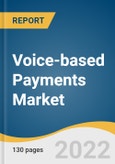The global voice-based payments market size is expected to reach USD 14.66 billion by 2030, expanding at a CAGR of 10.9% from 2022 to 2030. The growing adoption of voice commerce solutions worldwide is anticipated to drive the growth of the market. The strong emphasis payment service providers are putting on offering enhanced payment solutions also bodes well for the market growth.
According to statistics provided by the media company ComScore, approximately 50% of Google mobile searches were conducted by voice in 2020. However, a survey conducted in 2019 by fintech company Handsome and Ethik Connection, an event management company, of 120 people in France revealed that around 89% of the visually impaired people have already been the victims of errors and frauds while they were paying for services and goods. As a result, voice-based payment providers are particularly enhancing payment solutions for visually impaired people. For instance, a secure and discreet assistive technology solution offered by Thales Group and Handsome gives visually impaired people greater control over the payments they are making by vocalizing the transaction details.
The investments being raised by voice assistant solution providers are anticipated to create new opportunities for the growth of the market over the forecast period. For instance, in August 2021, Baidu Inc. announced that its artificial intelligence (AI) voice assistant, Xiaodu Technology, raised USD 5.1 billion in a Series B round. The fundraising came as the company continued to push forward with its ambitions aimed at AI chip designing and manufacturing.
The COVID-19 pandemic is expected to play a vital role in driving the growth of the voice-based payments market during the forecast period. People are particularly preferring touchless ordering and payments at fast restaurants in the wake of the pandemic, thereby opening new opportunities for the growth of the market. Touchless payments are in demand among restaurants due to their greater convenience, ordering accuracy, and reduced human contact.
This product will be delivered within 1-3 business days.
According to statistics provided by the media company ComScore, approximately 50% of Google mobile searches were conducted by voice in 2020. However, a survey conducted in 2019 by fintech company Handsome and Ethik Connection, an event management company, of 120 people in France revealed that around 89% of the visually impaired people have already been the victims of errors and frauds while they were paying for services and goods. As a result, voice-based payment providers are particularly enhancing payment solutions for visually impaired people. For instance, a secure and discreet assistive technology solution offered by Thales Group and Handsome gives visually impaired people greater control over the payments they are making by vocalizing the transaction details.
The investments being raised by voice assistant solution providers are anticipated to create new opportunities for the growth of the market over the forecast period. For instance, in August 2021, Baidu Inc. announced that its artificial intelligence (AI) voice assistant, Xiaodu Technology, raised USD 5.1 billion in a Series B round. The fundraising came as the company continued to push forward with its ambitions aimed at AI chip designing and manufacturing.
The COVID-19 pandemic is expected to play a vital role in driving the growth of the voice-based payments market during the forecast period. People are particularly preferring touchless ordering and payments at fast restaurants in the wake of the pandemic, thereby opening new opportunities for the growth of the market. Touchless payments are in demand among restaurants due to their greater convenience, ordering accuracy, and reduced human contact.
Voice-based Payments Market Report Highlights
- The software segment is expected to witness the fastest growth during the forecast period. The voice payment software being introduced aggressively by some of the major companies worldwide is expected to drive the growth of the segment.
- The small & medium enterprises segment is expected to witness the fastest growth during the forecast period. The growth of the segment can be attributed to the increasing number of small and medium enterprises worldwide.
- The BFSI segment dominated the market in 2021. The banks are adopting voice-based payments to meet their changing customer need which is one of the major factors that propelled the market growth in 2021.
- The Asia Pacific regional market is expected to witness the fastest growth during the forecast period. The growing demand for voice-enabled consumer electronics across the region is expected to play a decisive role in driving the growth of the regional market.
This product will be delivered within 1-3 business days.
Table of Contents
Chapter 1 Methodology and Scope
Chapter 2 Executive Summary
Chapter 3 Voice-based Payments Industry Outlook
Chapter 4 FinTech Industry Highlights
Chapter 5 Investment Landscape Analysis
Chapter 6 Voice-based Payments Component Outlook
Chapter 7 Voice-based Enterprise Size Outlook
Chapter 8 Voice-based Payments End-Use Outlook
Chapter 9 Voice-based Payments Regional Outlook
Chapter 10 Competitive Analysis
Chapter 11 Competitive Landscape
Companies Mentioned
- Ncr Corporation
- Amazon.Com, Inc.
- Paypal
- Paysafe
- Pci Pal
- Vibepay
- Cerence
- Huawei Technologies Co. Ltd.
- Alibaba
Methodology

LOADING...
Table Information
| Report Attribute | Details |
|---|---|
| No. of Pages | 130 |
| Published | April 2022 |
| Forecast Period | 2022 - 2030 |
| Estimated Market Value ( USD | $ 6.4 Billion |
| Forecasted Market Value ( USD | $ 14.66 Billion |
| Compound Annual Growth Rate | 10.9% |
| Regions Covered | Global |
| No. of Companies Mentioned | 10 |









